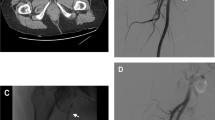Abstract
A pseudoaneurysm following percutaneous puncture can be treated by obliteration under ultrasound guidance using thrombin injection. This chapter describes indications, essential steps, variations, and complications of this procedure. It provides a detailed template operative note for the procedure.
Access provided by CONRICYT-eBooks. Download chapter PDF
Similar content being viewed by others
Keywords
Indication
-
Persistent large pseudoaneurysm following percutaneous femoral puncture
Essential Steps
-
1.
Local anesthesia
-
2.
Duplex identification of the pseudoaneurysm
-
3.
Introduction of the needle into the pseudoaneurysm
-
4.
Injection of microairbubbles to further verify the needle tip position
-
5.
Incremental thrombin injection until no flow is seen in the pseudoaneurysm
Note This Variation
-
Femoral pseudoaneurysms following percutaneous arterial punctures can be left alone (if small), compressed under ultrasound guidance or injected with thrombin as described in this chapter.
Complications
-
Persistent pseudoaneurysm
-
Leg ischemia
-
Femoral artery thrombosis or distal embolization
-
Nerve injury
Template Operative Dictation
Preoperative Diagnosis
Tender right/left femoral pseudoaneurysm
Procedure
Thrombin injection of right/left femoral pseudoaneurysm
Postoperative Diagnosis
Same
Indications
The patient is a ____-year-old male/female who recently underwent a percutaneous femoral puncture for diagnostic angiography/cardiac catheterization. Duplex ultrasonography revealed a large pseudoaneurysm measuring ____cm. Ultrasound compression of the pseudoaneurysm was unsuccessful. The risks and benefits of intervention were discussed with the patient, and he/she elected to undergo intervention.
Description of Procedure
Time-outs were performed using both preinduction and pre-incision safety checklists to verify correct patient, procedure, site, and additional critical information prior to beginning the procedure. The procedure was done under local anesthesia. The patient was placed supine. The right/left groin was prepped and draped in the usual sterile fashion. The duplex probe was placed in the lateral aspect of the left common femoral artery pseudoaneurysm, revealing a ____-cm pseudoaneurysm with an identifiable neck communicating with the left common femoral artery.
The skin was infiltrated with 1 % lidocaine. A 20-gauge spinal needle was introduced into the pseudoaneurysm under ultrasound guidance. The needle tip was visualized penetrating the pseudoaneurysm capsule. A few microbubbles of air were injected through the needle to further confirm its position within the pseudoaneurysm.
The injection solution consisted of thrombin 5,000 U mixed with 5 cc of normal saline. Thrombin was injected at increments of 500 U per injection.
The first injection produced a near obliteration of the pseudoaneurysm. After waiting approximately 2 min, there was some persistent flow within the pseudoaneurysm. Additional increments of 500 U of thrombin were injected, which successfully obliterated the pseudoaneurysm completely. Duplex investigation revealed no evidence of blood flow into the pseudoaneurysm. The needle was removed. The patient had no change in the quality of the pedal pulses following the procedure.
There were no complications.
A debriefing checklist was completed to share information critical to postoperative care of the patient.
The patient tolerated the procedure well and was taken to the postanesthesia care unit in stable condition.
Author information
Authors and Affiliations
Corresponding author
Editor information
Editors and Affiliations
Rights and permissions
Copyright information
© 2017 Springer Science+Business Media, LLC
About this chapter
Cite this chapter
Hoballah, J.J. (2017). Ultrasound-Guided Percutaneous Obliteration of Common Femoral Artery Pseudoaneurysm with Thrombin Injection. In: Hoballah, J., Scott-Conner, C., Chong, H. (eds) Operative Dictations in General and Vascular Surgery. Springer, Cham. https://doi.org/10.1007/978-3-319-44797-1_274
Download citation
DOI: https://doi.org/10.1007/978-3-319-44797-1_274
Published:
Publisher Name: Springer, Cham
Print ISBN: 978-3-319-44795-7
Online ISBN: 978-3-319-44797-1
eBook Packages: MedicineMedicine (R0)




